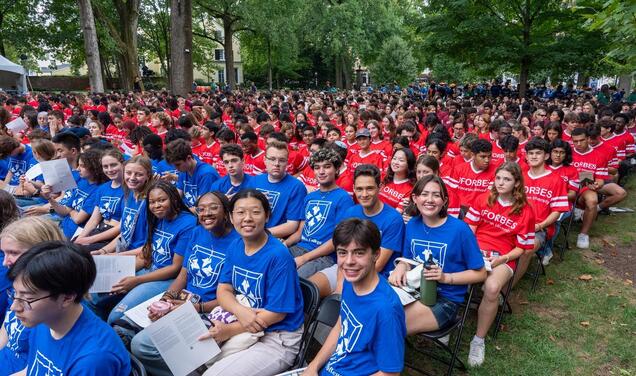
Lisa Halaby ’74 was among Princeton’s first female undergraduates and one of the first women to be a Tiger cheerleader. Friends said Halaby only wanted to cheer if she didn’t have to wear “those funny little skirts and bobby socks.” She wore “sailor pants” instead (and soon dropped cheerleading). As an undergrad, Halaby took a year off to learn about photography and alpine skiing. After her graduation, she worked for architecture firms in Australia, Iran, and Philadelphia. Then, 40 years ago, she married King Hussein bin Talal and became Queen Noor of Jordan on June 15, 1978.
Just before the wedding, the Princeton Alumni Weekly published a profile of the new royal (see below). It opened with a quote. “My career,” said Halaby, “is my life with His Majesty the King.” That career would prove to be about more than her private life or ceremonial roles. Her marriage was the catalyst for a life focused on public service. She became involved with the conservation movement in the early 1980s and has managed community development initiatives at the Noor al-Hussein Foundation since 1985. Her work there has included microfinance and family-health programs across Jordan.
King Hussein died in 1999, but Queen Noor has continued her service work as queen dowager. She serves on the International Commission on Missing Persons. She helped found Global Zero, a campaign to rid the world of nuclear weapons. Princeton recognized her achievements in 2015, when she received the Woodrow Wilson Award at Alumni Day. In her speech, she advocated for greater roles for women as policymakers in the Middle East: “Women are not just a special category of problems to be addressed or ignored. They are the key to the solution. ... Opposed to violence, whether by tradition, temperament, or training, they have long relied on creative strategies to stop war and nurture peace.”
Lisa Halaby ’74: ‘A Natural for a Queen’
(From the June 5, 1978, issue of PAW)
“My career,” said Elizabeth “Lisa” Halaby ’74 last month in Amman, Jordan, “is my life with His Majesty the King.” When she weds Jordan’s King Hussein ibn Talal el-Hashim on June 15, the former member of Princeton’s first co-educational class — who was briefly one of the university’s first female cheerleaders — will also become Princeton’s first Queen. (Although born and raised in America, she qualifies for the title by virtue of being of Syrian and Lebanese descent.) But joining the royal household of a small, conservative Moslem country that places severe strictures on the role of women will mean a sharp change in lifestyle for Halaby, a well-traveled, cosmopolitan careergirl with a taste for adventure and a preference for casual clothes.

In the early news dispatches, Thomas C. Southerland, an assistant dean of the Architecture School, was quoted coastto-coast as saying, “She’s a natural for a queen.” He got to know Halaby when she was elected to the school’s Committee of Student Representatives and was struck by her “charming manner” and “disarming smile.” He recalls, “She seemed to feel at ease in any situation.” Harrison S. “Pony” Fraker Jr. ’64, one of her teachers, found her “savvy, bright, quick” — a good student though not exceptional — and felt she had a definite “air about her.” He adds, “She was one of those students you’d want to know what happened to later on. Now I do.”
The daughter of former Federal Aviation Administrator and recent Pan Am President Najeeb Halaby, who now heads his own international corporation exporting Western technology to developing nations, Lisa was born in Washington, D.C. and grew up in Alpine, New Jersey, and New York City. She came to Princeton from Concord Academy in Massachusetts, where she played field hockey, basketball, and lacrosse, worked on the school newspaper and yearbook, participated in the debating club, and earned a reputation for being high-spirited and venturesome.
A tall, lithe blonde, she was regarded as among the most attractive women in the first coed Freshman Class. Her prepschool friend Rose “Podie” Lynch ’71, who joined her in becoming Princeton’s first female cheerleaders, recounted to People magazine: “We said we’d only do it if we didn’t have to wear those funny little skirts and bobby sox. She and I wore sailor pants instead. But after about four games Lisa and I decided it was ridiculous and dropped out. We felt dumb.”
Halaby took a year’s leave from college in 1971-72, studying photography and skiing at Aspen, Colorado, where she supported herself by waitressing and ran around with a group of peace activists associated with political prankster Dick Tuck. On her return to Princeton the next fall, she plunged into her architectural studies with a new seriousness, spending long hours at her drawing table in the Architecture Building’s studio, surrounded by a mass of potted plants. During her senior year, she set up house off-campus with fellow architecture major Patterson, with whom she shared an interest in ceramic pottery. According to one of their professors, the relationship was “more like good friends than an intense romance,” and upon graduation they went off to pursue their separate careers.
Halaby’s first job was as an urban planner in Sydney, Australia, and later in Tehran, Iran. She returned to the U.S. during the Bicentennial, working for the Greater Philadelphia Cultural Alliance on a directory of the city’s cultural facilities. Then she took a position as an architect and designer for Arabair Services Corporation, an AmericanArab firm with offices in New York and Amman. About 16 months ago, she became a director of architecture and design for Alia, the Royal Jordanian Airlines, and began visiting Amman regularly. One of her major projects was assisting in the design of Alia’s New York office, scheduled to open later this year.
Accounts vary as to how long Halaby has known Hussein, but apparently she met him through her father and began seeing him frequently about three months ago. The king, an avid pilot, reportedly took an interest in her work for the airline, and they soon found they had in common a passion for sailing, skiing, and speedy sports cars. The romance progressed rapidly, and last month the royal court announced that Hussein had chosen Halaby as his “life partner.” In keeping with a Jordanian tradition that the monarch’s wife must have an Arabic name, the King renamed her “Nur el Hussein”—the light, or gleam, of Hussein.
Hussein, at 42, has been King of Jordan virtually as long as Halaby has been alive. Although a reputed playboy in his youth, he has seen his grandfather assassinated, his father driven insane on the throne, and numerous attempts on his own life. Without enjoying the benefits of oil, his nation has been in the center of every Mideast crisis for the past quarter-century. His first two marriages ended in divorce and his third wife, American-educated Queen Alia, was killed in a helicopter crash just last year. His friends are hoping that Halaby will be able to light up the strife-weary monarch’s life.
In preparation for her new royal career, Halaby is learning Arabic and converting from Christian Science to Islam. Besides serving as Hussein’s consort at official functions, her duties will include overseeing all Jordanian charities and looking after the nation’s social development. Moreover, the wife of the chief of Hussein’s Cabinet told a New York Times reporter last month, “I think she could play an important role in improving the quality of life here. She has the upbringing and the stamina to adjust herself to this society.”










No responses yet